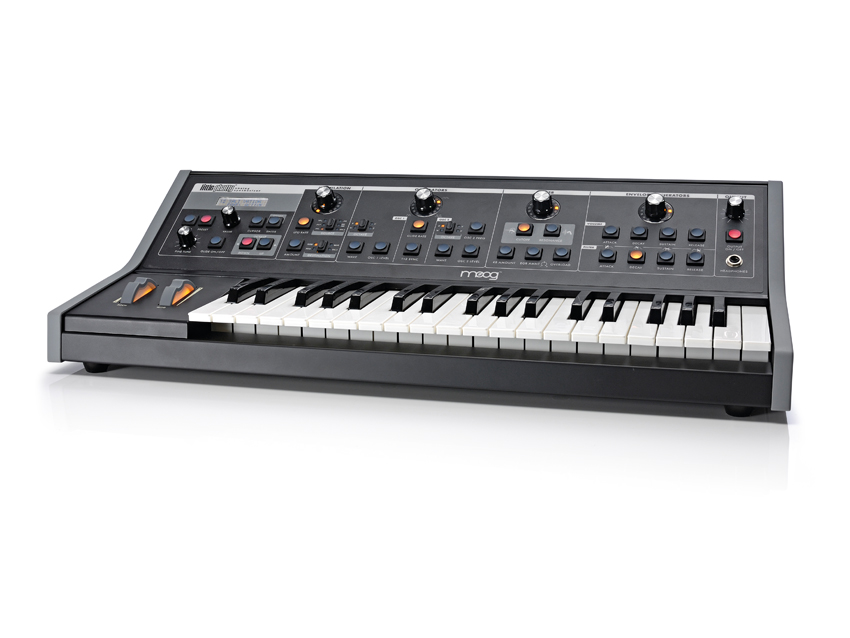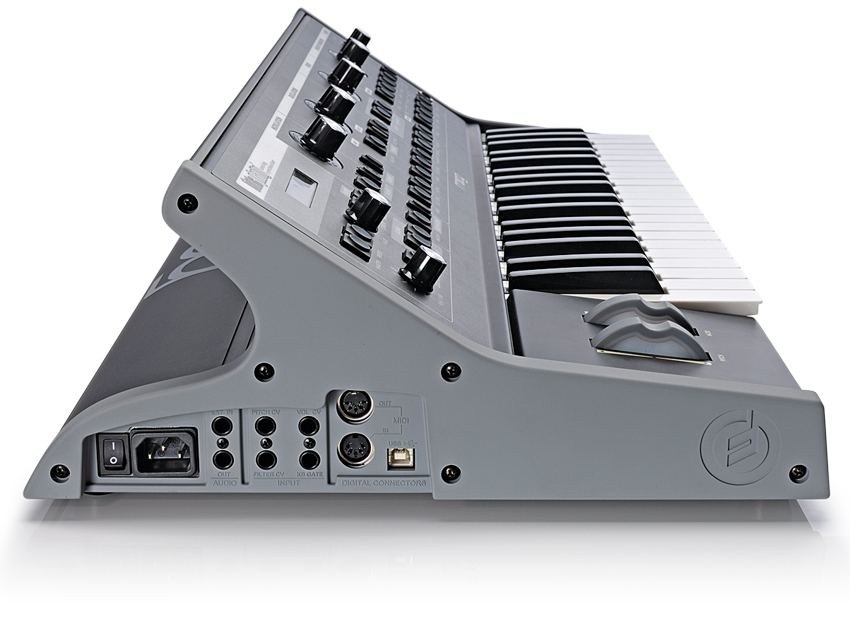MusicRadar Verdict
Juicy and dirty analogue sounds for the stage and studio at a great price.
Pros
- +
Overload the filter and make it scream. Sync the LFO and arp to MIDI clock. Quick and easy to use.
Cons
- -
Not exactly innovative.
MusicRadar's got your back

Moog Little Phatty Stage II

Moog Little Phatty Stage II
This is the third revision of the Little Phatty, and is both a hardware upgrade - by way of the new USB port - and a software one (there's a new OS). The USB port brings MIDI functionality direct to your computer with no need for drivers, while the new OS adds an arpeggiator, tap tempo and LFO synchronisation to incoming MIDI clocks.
In detail
It all starts with two of the juiciest analogue oscillators money can buy. Real analogue oscillators can suffer from tuning instabilities caused by temperature changes and the like, so Moog has made a conscious effort to ensure that the LP stays in tune on stage and in the studio by upgrading the auto and manual tuning calibrations on the Stage edition.
Most synth aficionados know all about the notoriously creamy 'Ladder' filter found in classic Moog designs. This 24dB/octave low-pass filter can be modified in the Master section using four Pole settings. Choosing between one and four poles alters the steepness of the cutoff point, giving tweakers a chance to indulge the full personality of the Ladder.
The difference is pretty obvious even to untrained ears. At low resonance settings, four poles will kill the sound sharply for precise, warm bass tones. Use the same settings on one pole and you get fuzzy, raspy sounds.
At the other end of the scale, crank the resonance up full and the four-pole will remain supremely smooth, while the one-pole will scream and ring out like a mad man. Don't miss out on this trick as it's a real winner for maximising the Phatty's potential.
The Overload dial adds to the LP's reputation as the wild and dirty monosynth. Some hard-nose purists have griped about the Voyager's lack of 'bite' when compared to a vintage Minimoog, but there have been no such criticisms of the LP as you can dial in all the 'balls' you like.
The Overload cranks up the gain both pre- and post-filter, from gentle saturation to out and out distortion. It can pound a triangle wave into a harmonically rich squared-off waveform and adds several dBs of gain to the output volume.
"Old-school keyboard wizards will love the arrival of the arpeggiator - it enables many of those classic '70s and '80s synth sounds to be recreated."
The KB amount tracks the cutoff to the keyboard and at full tilt it tunes the resonance in perfect intervals to the keyboard scale. It adds a lovely dimension of overtones when combined with the oscillators, and can be played like an oscillator in its own right.
The EG amount swings both ways, positive and negative zero-ing in the centre, and it can also respond to KB velocity for maximum expression and MIDI programmability.
The envelopes are simple four-stage ADSR jobbies and sound quite linear to our ears. For the record, they are pure VCAs, and are fast enough to satisfy the snappiest of percussive needs, if needs be. We also tested them over MIDI by drawing CCs into Logic/Live and the response was lightning fast (as were all the parameters), so all good round here.
The Modulation section is simple and can route one source to one destination, with the amount controlled by the Mod wheel. It has a full complement of waveforms plus S+H, Filter EG, Noise and OSC 2 as sources which give it plenty of scope.
Live playability has been expanded. Old-school keyboard wizards will love the arrival of the arpeggiator as it enables many of those classic '70s and '80s synth sounds to be recreated authentically.
The Arp follows the LPs old-school philosophy by offering the three basic patterns of Up, Down, Order and combining them with Loop, Back-Forth and One-Shot modes of execution. Division, latching and octave range can be dialled in along with all the other settings by way of the Master menu and value knob.
Sync can be either internal to the LFO rate, MIDI Clock or tap tempo, which is engaged by tapping the LFO rate button till it flashes. Clicking the value dial engages the arp. You have to be careful to give it a firm push otherwise it can change the preset.
It doesn't take long to get acquainted with the LP's minimalist panel. It makes good use of illuminated orange buttons so you can keep track of the current parameter that each dial is editing.
A nice twist for maximising the small number of dials comes from the Pot Mapping feature. This lets users map any internal function or MIDI CC to any of the four dials, without disrupting the current setup. It definitely comes in handy - when you want to tweak both the resonance and cutoff on the filter, for example.
Summary
The new features give the LP a definite advantage over its predecessors, making it more playable and tighter in the studio. It does take a little more time to set things up we're talking mainly about the arpeggiator and LFO timings - but this is to be expected as there are no new front panel controls.
Original Stage owners can upgrade the OS for free but will need to buy the USB kit or send their keyboard back to get it fitted.
The LP has matured and feels more complete and well-rounded. And since there's no change in price, it's even more fun and better value than ever.
Hear the classic Moog sound in these Little Phatty Stage II audio clips:
Future Music is the number one magazine for today's producers. Packed with technique and technology we'll help you make great new music. All-access artist interviews, in-depth gear reviews, essential production tutorials and much more. Every marvellous monthly edition features reliable reviews of the latest and greatest hardware and software technology and techniques, unparalleled advice, in-depth interviews, sensational free samples and so much more to improve the experience and outcome of your music-making.
What’s the buzz? Meet Yellowjacket, Cherry Audio's recreation of EDP’s trend-setting Wasp from 1978
“A fabulous trip through all eight songs by 24 wonderful artists and remixers... way beyond anything I could have hoped for”: Robert Smith announces new Cure remix album
“He knows what I'm thinking and feeling before I even know it": Billie Eilish suggests that she and brother Finneas can read each other's minds










